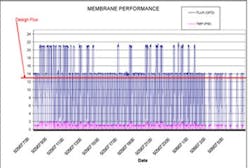Expanding Capacity in a Growing Community
Located near Atlanta, Paulding County is one of the fastest growing counties in the U.S. Consequently, the county continues to see an increasing demand for potable water usage and wastewater treatment. The area’s Pumpkinvine Creek Water Reclamation Facility (WRF) selected Enviroquip’s MBR technology for the initial phase of its 1 million-gal-per-day (mgd) plant. Operation began in 2004 to service the Bentwater subdivision, the Seven Hills master planned community and the Governor’s Club developments.
The treated effluent provides irrigation to local landscapes and golf courses. This reusable effluent has allowed Paulding County to dispose its treated wastewater in a beneficial way that offsets the water demand on the municipal water system. This advantage has been beneficial to local residents mindful of their own water consumption, and it was particularly significant during the Georgia’s 2007 drought.
After three years of low maintenance and excellent hydraulics and biological performance, the Paulding County Water System selected Enviroquip again for further plant expansion of the existing MBR system. This latest expansion phase is expected to deliver an extra 2 mgd of treatment capacity for a total of 3 mgd.
Expansion Phase
With two individual process trains, the expansion will handle an average daily flow of 2 mgd and a peak day flow of 4 mgd. Each train consists of anaerobic, anoxic, preaeration and membrane zones. To reduce the amount of ferric or alum addition, anaerobic zones for enhanced biological phosphorus removal are used to achieve phosphorous limits of 0.13 mg/L.
Exceeding Expectations
Due to an initial projection of demand, only half of the existing Pumpkinvine Creek MBR plant was installed and open to operation in its first two years. During that time, the plant was rated to 0.5 mgd. However, 150% of flow was still being processed (0.75 mgd). The result was a higher-than-expected operating flux of up to 18.2 gal per sq ft per day. The plant was designed to process a flux of only 12.1 gal per sq ft per day. In the following months, Enviroquip engineers discovered that the Pumpkinvine Creek plant could successfully process these increased flows. Chart 1 shows a typical day.
Chart 2 demonstrates the plant’s ability to run high fluxes. The increased flux was not occurring 100% of the time, but rather in smaller intervals. The net result was that Pumpkinvine Creek WRF has consistently and successfully run above design flux. And these flux rates are all possible even while meeting regulations and permeated water is being reused on nearby agricultural landscapes.
System cost, throughput flexibility, plant robustness and the ability to produce reusable effluent in an outdoor-centric family community demonstrate the ability of MBR systems to be competitive and reliable alternatives to conventional technologies. Because award-winning community development means unsurpassed quality of life for residents and straightforward, eco-friendly municipal services, the Pumpkinvine Creek WRF proved that Enviroquip’s MBR system is on the forefront of technology.
